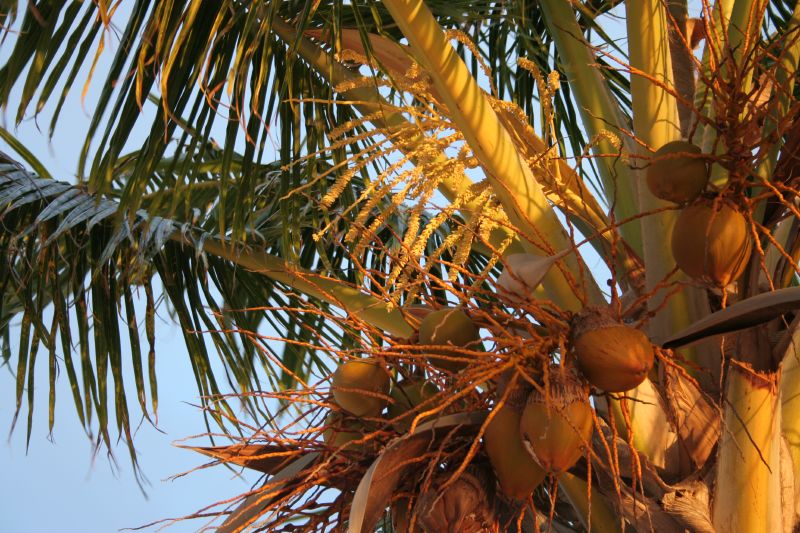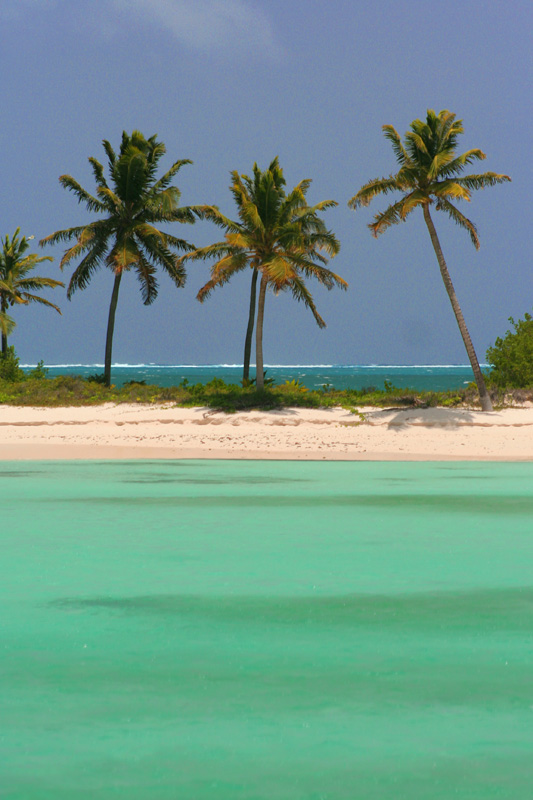I took that shot at Cocopoint on the south coast of our sister island Barbuda. It’s the ultimate Caribbean description isn’t it? A dazzling green bay with a beautiful beach occupied only by coconut trees.
Some of my earliest memories are of hanging out with Tyrone, the coconut man, down at my grandparents hotel as he walked up the trees to collect coconuts. Yes, that’s right, he could walk up a sixty foot high coconut tree as if he were a super hero. When he came back to earth he’d open a “jelly nut” as he’d call them in about a second and a half with his cutlass and give it to me as if i were a little prince. I have always loved coconut trees and there are hundreds of ways that they have been part of my life since childhood. The sound they make in the winds, the way moon light sparkles off their branches, the animals that take refuge or feed there. I can’t imagine our island without them. An island without coconut trees and other palms may be hard to imagine, but it looks like unless something dramatic happens here this will be a terribly sad reality for us all.
Lethal Yellowing is a palm tree disease which has found it’s way to the shores of Antigua and is killing coconut palms quickly. From www.palmtreesaver.com/
LY is spread by the planthopper insect Myndus crudus. Myndus crudus feeds by piercing the frond (leaf) and sucking out the sap in the phloem tissue. If a tree is infected with LY, the disease is ingested by Myndus crudus. As the insect moves from tree to tree the disease is spread. This insect only lives in warm locations. The vector for TPPD is unknown at this time but it is also likely to be a planthopper.

Symptoms of Lethal Yellowing seem to start with the flowers (the area where the tiny coconuts start). These begin to darken and shortly after that you start to notice the oldest branches getting yellow and darker. The lethal yellowing symptoms spread from the older branches inward to the newest branches and soon the entire tree looks like it’s on it’s way out. Sadly, it is. For more on the symptoms with photos click here.
Many trees have died here and so many more are infected. Take a drive to Dickenson Bay and have a look around. Many are being cut down and destroyed. On Friday I noticed many trees perishing in the Trade Winds area. It seems as though the government is worried about the short term prospect of displacing coconut water workers if trees are treated island wide. Rather is seems they are holding back treating trees so that the very small industry can hold on. I guess they will hold on until there are no trees left on the island because that’s what will happen unless all the trees are treated. Short term is the way we think here on Antigua though.
IF you suspect that you have palm trees on your property that may be showing signs of Lethal Yellowing please contact Plant Protection Officer in the Ministry of Agriculture Kishma Primus on 268 764 7378.
You can also email my friend Martin Dudley on zerowasteantigua@gmail.com. He is a local arborist who has taken on this very important issue and is trying to help individuals, hotels and the country as a whole find ways of dealing with it. It seems as though the government is being slow to act and there is quite a bit of frustration as to why the issue isn’t being treated with more of a priority on the national level. I guess that sounds like the whole fisheries issue. I guess not a surprise that Agriculture, Fisheries and the Environment come under one roof.

